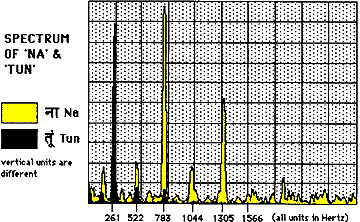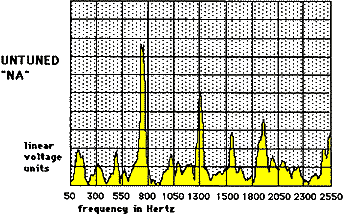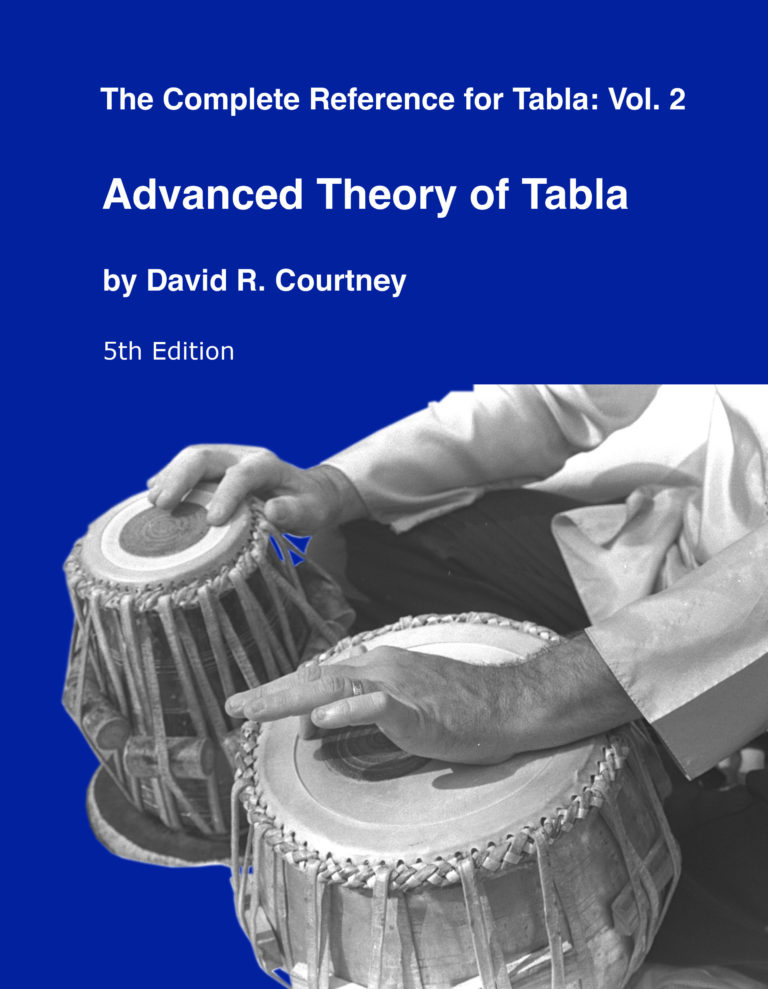NOTE – This article originally appeared in PERCUSSIVE NOTES, Volume 29, Number 3, February 1991, Pages 59-61
Reprinted by permission of the Percussive Arts Society, Inc., 701 N.W., Ferris, Lawton, OK 73507
More information on the subject is to be found in the book,
Advanced Theory of Tabla
Background
Tabla is the most popular drum in northern India. For centuries it was largely unknown in the West; yet, in the past few years it has established itself among many Western musicians. However, musicians who embrace this instrument are faced with major difficulties – tuning, for example. All percussionists face problems with tuning, but the strong pitch of tabla, coupled with the extreme precision required of Indian music make it an even greater challenge. This article will explore the psychoacoustic processes involved in tuning a tabla.
It is often said that pitch corresponds to the frequency of vibrations of air. Unfortunately, things are not quite so simple. The main complication is that the natural sounds we hear every day are never only a single frequency. They are a complex mixture of a number of different frequencies. The nature and relationship of these component frequencies form the major physical foundation for timbre. (Helmholtz, 1862) Under most conditions the lowest component frequency will be the fundamental, and the remainder of the frequencies will be called the overtones. A more realistic definition of pitch would equate it with the fundamental frequency, while the overtones determine the timbre. The process of breaking down a sound into its components is referred to as spectral analysis. Spectral analysis of Indian drums is not new. The pioneering work was done by Raman (circa 1929) and has been refined by numerous investigators over the decades. (e.g., Banerjee, et. al-1989) However, no one has attempted to look at this body of information from any psychoacoustic standpoint, or consider its relevance to the vexing problem of tuning.
Procedure
A calibration tone (-20 dB pink noise) was recorded onto a high quality cassette recorder. This tone was later used to make fine adjustments by way of a 1/3rd octave equalizer. Various strokes of the tabla were then recorded. These recorded samples were then analyzed with Hewlett/Packard spectrum analyzer. Although numerous samples were analyzed, attention was placed upon only two strokes; “NA” and “TUN.” “NA” was chosen because this is the stroke of choice for tuning tablas and “TUN” was chosen because it is the only stroke that is totally unencumbered by the fingers or palm; therefore, it represents the resonant characteristics of the entire drum.
Results
The resultant spectra were then analyzed from a psychoacoustic standpoint. The results were compared with both established psychoacoustic principals as well as the author’s experience of teaching tabla to hundreds of students over a ten-year period.
One of the striking findings about the work is that the more common explanations of pitch perception by way of the fundamental are not always applicable. This is undoubtedly due to the fact that tabla, like most drums, is in a curious grey area between pitched and unpitched musical instruments.
One must remember that there are curious twists to the brain’s process of determining pitch. A pitch can be perceived even if the fundamental is absent. Therefore, one may distinctly hear a pitch for a frequency that is not even there, reflecting the brain’s ability to look at pitch from the standpoint of a complete spectrum instead of unrelated frequencies. It appears that this phenomenon is especially significant for determining the pitch of many tabla strokes.
Armed with this information we may now look at a couple of tabla strokes from the standpoint of tuning. Figure 1 shows the spectrum of two of the major pitched-strokes of tabla. This chart shows a tabla tuned to C. The spectra of two strokes, “TUN” (an open stroke) and “NA” (a stroke which is muted), are shown. One may easily see that the “TUN” stroke has a very pronounced fundamental with lower amplitude harmonics (overtones). Conversely, “NA” essentially has no fundamental, but a very pronounced third harmonic (783 Hz). It is clear that the “TUN” stroke has a much clearer pitch.

However, the “TUN” stroke is never used for tuning purposes. The reasons are very important yet not intuitively obvious. We should remember that the spectra in Figure 1 were taken under ideal conditions. The tabla was known to be of excellent quality and tuning. (Courtney-1985)
One common problem is that many tablas are not well made. Figure 1 shows the frequencies of the spectral lines for “NA” at the same position as for “TUN.” Therefore, the pitch of “NA” and “TUN” are the same. Unfortunately, in many low-quality tablas, playing “NA” elicits a different pitch from “TUN.” This is a consequence of an improper relationship between the thickness of the shai (the large black spot) in the center and the thickness at the edge. Since the stroke “NA” is a far more common stroke than “TUN,” it is only reasonable that “NA” should be given preference in determining the pitch.
(Author’s note – since the initial publication of this work it has become clear, that one will almost NEVER find a tabla whose TUN and NA represent the same pitch. Although the exact interval varies from drum to drum, the “fundamental” is normally about one step above the pitch that the tabla is tuned to.)
Another reason why “NA” is used to determine the pitch is surprisingly simple. A significant flaw of an untuned tabla is that tension is not equal around the perimeter. “NA” is very convenient because it allows us to see the tension under a small section of the perimeter. We may then decide whether that section needs to be raised or lowered.
Unfortunately, even under the best of conditions, the ability to perceive pitch in the “NA” stroke is strained. In addition, the conflicting resonant mechanisms of an untuned tabla will overwhelm the average person’s ability to discern pitch.
Figure 2 shows several interesting features. One feature is the very broad peak at about 770Hz. Closer examination reveals that this is not one but actually two different peaks located about a half step apart. This is very significant because this peak normally corresponds to the third harmonic (second overtone). Since the fundamental is suppressed, this prominent third harmonic is very important in the brain’s effort to extrapolate downward to determine the fundamental’s position. The double peak is a very powerful obstacle to the proper functioning of this mechanism. The brain’s effort to determine the pitch is further hampered by a number of prominent but unrelated peaks in the general area where the brain is expecting to find a fundamental. The result of such an inharmonic spectrum is that different people tend to hear different pitches or worse, no pitch at all.

It has been shown that one of the major obstacles to the easy tuning of tabla lies, not in the instrument, but in the perceptive mechanisms of the brain. The key to being able to tune a tabla lies in having enough experience to be able to correctly perceive pitch in such a strongly inharmonic spectrum.
The results of this work may be of tremendous practical advantage in the field of music education. Much contemporary musical training concentrates on the neuromuscular aspects of the subject. Even the ear training in standard education does not adequately address the psychoacoustic processes. Perhaps tabla could be used as an educational tool to help purely Western musicians develop the necessary skills to tune Western drums. There is a tendency for Western percussionists to be quite careless in the tuning of their drums. Western drums have to be tuned to something; yet, all too often, they are not even tuned to themselves simply because the user does not take the necessary time to learn. A consideration of psychoacoustic principals in the education process could alleviate this problem.
References
Banerjee, B.M., Nag, Dipali. “A Scientific Study of ‘Tabla’ Sounds,” Sangeet Research Academy Journal. 5,1 Calcutta: SRA 1984.
Banerjee, B.M., Nag, Dipali. “A Scientific Study of the Sounds of Banya,” Sangeet Research Academy Journal. 6, 1 Calcutta: SRA 1984.
Banerjee, B.M., Nag, Dipali. “A Comparison of Acoustic Characters of Sounds from Indian Drums,” Journal of the Acoustical Society of India. XVII 3 & 4 Calcutta: ASI 1989.
Courtney, David. “Introduction to Tabla”. Hyderabad: Anand Power Press, 1980.
Courtney, David. “Tabla Making In The Deccan”, Percussive Notes. 23, 2 January, 1985).
Courtney, David. “The Tabla Puddi”, Experimental Musical Instruments. IV, 4 (December, 1988).
Helmholtz, Herman. “On the Sensations of Tone”. New York: Dover Publications, 1954.
| IF YOU ARE INTERESTED IN TABLA, THIS BOOK IS FOR YOU |
|---|
This is the second volume of the most complete series on the tabla. Advanced Theory of Tabla It is available around the world. Check your local Amazon for pricing. |